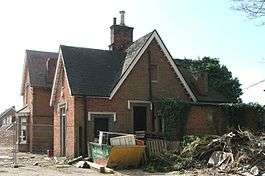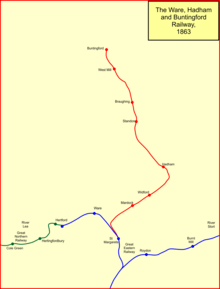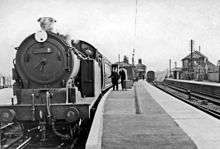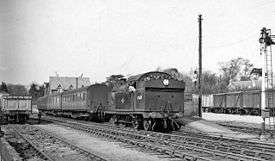Buntingford branch line

The Buntingford branch line was a railway branch line in Hertfordshire, England connecting Buntingford to the railway network at St Margarets. It was promoted locally and opened in 1863; it had significantly overspent its available capital, and only completed its line with the assistance of the neighbouring Great Eastern Railway. Residential travel and goods services became significant at the end of the nineteenth century and the train service was enhanced accordingly. Nevertheless the area served by the line remained predominantly agricultural, and after 1948 use of the line did not keep pace with rising costs. When the adjacent Hertford East branch was electrified, the Buntingford branch trains were reduced in frequency and quality. The line was cited for closure in the Beeching Report, and the passenger service was withdrawn in 1964; goods services were closed in 1965, and there is no further railway use of the line.
The line was informally known as The Bunt by those who worked on the line.[1]
Proposals

Buntingford was located on Ermine Street, and as such had a prime position as a trading town before the advent of railways, on the road from London to Cambridge and the north.[2] The town was by-passed by the main line of the Eastern Counties Railway from London to Cambridge via Bishop's Stortford, which opened in stages between 1840 and 1845. The Ware and Hertford branch from Broxbourne was opened by the Northern and Eastern Railway in 1843.[3][2]
In 1845 during the Railway Mania, a grandiose scheme to build a Great Western, Southern and Eastern Counties Railway was proposed; it was to run from Southampton to Ipswich via Bishops Stortford and Hadham. Its cost and ambition were clearly unrealistic and it did not proceed further. Then in 1847 George Hudson promoted a Parliamentary Bill for an alternative route to Cambridge, leaving the Hertford branch at Ware and running via Buntingford and Royston to Shelford. This too failed to gain approval.[3]
Authorisation
On 1 August 1856, a meeting of 150 landowners in the district was held at the George and Dragon Hotel, Buntingford, to discuss the possibility of promoting an independent branch line to Buntingford; a local proponent of the scheme, George Mickley, said his estimate was £70,000 for the construction of ten miles of single track railway, plus £30,000 for land and stations, making a total of £100,000. Annual receipts were forecast to be £10,083, and a 5% profit was to be expected. A second meeting was held on 28 August, and it was reported that there had been no opposition locally when people were circulated by letter, so it was decided to proceed. A Parliamentary Bill was submitted in November 1857 for the line. The Bill passed through Parliament and the Royal Assent was granted for the Ware, Hadham and Buntingford Railway on 12 July 1858; authorised share capital was £50,000.[3][2][4]
A tender of £44,000 for the construction was accepted from W S Simpson of Ely; the engineer was Henry Palfrey Stephenson; the first sod was cut at a ceremony on 20 July 1859.[3][2]
During the process of land acquisition, exceptional difficulty was encountered with a landowner near Ware, and the decision was eventually taken to alter the route of the line to join the existing Hertford branch at St Margaret's instead of at Ware. Many other difficulties were encountered in getting possession of the necessary land. A deviation Bill was submitted in 1860 to improve the gradients and shorten the line; it gained the Royal Assent on 22 July 1861. A well as expensive demands from landowners, there were an unusual number of bridges on the line, also increasing the cost per mile of construction.[5][3][2]
In addition, there was a considerable shortfall in subscribed capital; as was usual, the borrowing powers in the company's Act of Incorporation were conditional on a proportion of the capital having actually been subscribed. The directors considered mortgaging the line, but it proved impossible to find a financial house willing to take debenture shares and for the time being the Company lacked funds.
The line, when completed, would effectively be a branch of the Eastern Counties Railway. However the Great Northern Railway had a branch line to Hertford from Welwyn, and there was always a possibility that the Buntingford line might be sold to the GNR; accordingly the ECR was motivated to assist the local company, and it agreed to provide financial assistance to the extent of £22,000. Two ECR board members joined the WH&BR board, and the ECR agreed to work the line for 50% of receipts. In 1862 the ECR and other railway companies in East Anglia amalgamate to form the Great Eastern Railway.[3]
By 1863 the line was substantially ready, and the Board decided to arrange a special train for shareholders to attend the Shareholders' Meeting in Buntingford. This took place on 10 February 1863; the special train ran from London to Buntingford, taking 45 minutes for the journey.[3][2]
An inspection by an officer of the Board of Trade was necessary before public passenger operation could start, and Captain J H Rich visited the line for the purpose on 18 April 1863. He was critical of the state of the railway: the permanent way was below the required standard, and the underbridges were badly constructed; one of these, Bog Ford Bridge, was reported to have sunk three inches under the inspection train; there were no facing point indicators, no turntable at St Margaret's, and several stations had no distant signals. There was inadequate fencing, and overbridges were not properly fenced on the road approach wing walls.
This was a serious blow to the company, which had assumed that early opening was within their grasp. Bog Ford Bridge was reconstructed; a 91 feet depth of piling was required to get a proper foundation. All this work committed the Company to considerable unforeseen expenditure, and a further Act of 22 June 1863 obtained authorisation to take an additional £40,000 share capital.[3]
Opening

The rectification was quickly put in hand, and on 30 June 1863 Col Yolland inspected the line once again. He was still not entirely satisfied, but he reluctantly gave approval this time. The first trains ran on 3 July 1863; there were four trains each way daily, and two in Sundays. the journey time was 50 minutes, reduced to 40 minutes from 1 August 1863.[2] There were minimal goods facilities for some time at the beginning. Income for the first quarter year (to 30 September 1863) was £1,221, of which £359 was from goods traffic.[6][3][2][7]
The goods trains caused congestion on the single line, and the Board decided that a passing loop at Hadham was required; expenditure of £220 was authorised 24 May 1865; the work was to be done by the GER at the Buntingford company's expense. Braughing followed as a crossing point in 1892.[7]

The line had been expensive to build, and was only completed with considerable financial help from the Eastern Counties Railway and its successor company (from 1862), the Great Eastern Railway. The entire capital subscribed including GER subscription was £106,871; there were outstanding liabilities of £50,000 and debenture debt was £29,403. This state of affairs could hardly continue long, and the company wrote to the GER on 21 June 1865, asking them to take over the line. The Board admitted the obvious: they were "not yet in a state to pay a dividend".[3]
Walter Bentinck had debenture bonds falling due on 10 February 1866. The company was unable to pay, and Bentinck took them to the Court of Chancery; he obtained judgment in his favour for £3,039, "payable in land if not in cash". The company had no cash and no spare land, so the matter escalated, and in the end the GER paid Bentinck in November 1866, in order to settle the matter. On 7 March 1867, the GER, realising that any initiative now rested with it, wrote to the Company suggesting absorption. The GER motivation was the continuing fear that the Great Northern Railway might get control of the Buntingford company and use it to gain entry into GER territory.[3]
Shareholders of the Buntingford Company met on 26 March 1867 and voted in favour of selling to the GER; the deed of transfer was ratified on 30 July 1868, effective on 1 September 1868.[3][8][2]
Due to poor usage, Widford station was closed after 31 Dec 1868. However a petition was raised locally protesting, and it was reopened on 1 April 1869.
Change in the late nineteenth century
Safety improvements were demanded by the Board of Trade, and the block telegraph system was installed between St Margaret's and Mardock, operational from June 1888; it was extended throughout the line between 1892 and 1893 at a cost of £15,277.[3]
From this period the revenue on the branch increased considerably as residential travel became an important business; in addition goods usage on the line was brisk.[3] By 1900 there were seven trains each way daily, with two on Sundays; the journey time was 35 minutes, and there were three goods trains each way daily. From July 1915 the passenger service reached its peak, with eleven trains in each direction.[2]
A local bus operator started passenger services in the district from 1920, but the London residential traffic was gaining strength; from 1922 there was a homeward through train from London, although the counterpart London-direction through train did not start running until 1939.[2]
From 1923

In 1953 a film was made including location shots at Braughing; the film was set in Ireland at a village called Rathbarney, and Braughing station was made to resemble the fictitious station. The film had the working title O'Leary Night, but was released in 1954 as Happy Ever After; it also had the title Tonight's The night.[9] [3]
Sunday services were withdrawn from the passenger timetable after 18 September 1955.[3][7]

From 15 June 1959, diesel multiple units were introduced on the passenger services on the line; for some time at the beginning they were extremely unreliable. Through trains to London from the branch were withdrawn at this time too.[2][3] In 1960 the Hertford East branch was electrified; it was effective from 21 November 1960; the Buntingford branch timetable was altered to suit connections with the electric trains, but there was only a service in the morning and evening peaks, except on Saturdays.[2][7]
In 1961 another film was shot using a location on the branch: West Mill station was used to film Postman's Knock. Spike Milligan played a naive country [postman who unwittingly foils an attempted train robbery.[10][3]
Closure
In the 1960s the area served by the branch had not developed as an intensive commuter residential area, and when the Beeching Report was published, the branch was shown for closure. The passenger service was withdrawn from 16 November 1964, and the final goods train ran on 17 September 1965.[3][11][3][7]
Topography
| Buntingford branch line | ||||||||||||||||||||||||||||||||||||||||||||||||||||||||||||||||||||||||||||||||||||||||||
|---|---|---|---|---|---|---|---|---|---|---|---|---|---|---|---|---|---|---|---|---|---|---|---|---|---|---|---|---|---|---|---|---|---|---|---|---|---|---|---|---|---|---|---|---|---|---|---|---|---|---|---|---|---|---|---|---|---|---|---|---|---|---|---|---|---|---|---|---|---|---|---|---|---|---|---|---|---|---|---|---|---|---|---|---|---|---|---|---|---|---|
| ||||||||||||||||||||||||||||||||||||||||||||||||||||||||||||||||||||||||||||||||||||||||||
- St Margaret's; opened 31 October 1843; relocated west of level crossing 3 July 1863; still open;
- Mardock; opened 3 July 1863; closed 16 November 1964; alternatively known as Mardocks in early years;
- Widford; opened 3 July 1863; closed 16 November 1964;
- Hadham; opened 3 July 1863; closed 16 November 1964;
- Standon; opened 3 July 1863; closed 16 November 1964;
- Braughing; opened 3 July 1863; closed 16 November 1964;
- West Mill; opened 3 July 1863; closed 16 November 1964;
- Buntingford; opened 3 July 1863; closed 16 November 1964.[3][12]
There were passing loops at Braughing and Hadham.
The route was 13.8 miles (22.2 km) in length.
The line was steeply graded, rising at gradients of up to 1 in 63 as far as the summit of the line about three-quarters of a mile beyond Hadham. After that the line falls at 1 in 56, with more moderate gradients from there to the terminus.
References
- ↑ Buntingford Railway and Local History Society, at
- 1 2 3 4 5 6 7 8 9 10 11 12 13 B D J Walsh, The Ware, Hadfield and Buntingford Railway, in the Railway Magazine, July 1963
- 1 2 3 4 5 6 7 8 9 10 11 12 13 14 15 16 17 18 19 20 21 Peter Paye, The Buntingford Branch, John Masters (publisher), Bishops Stortford, 1980 and 1996, ISBN 1 901190 00 5
- ↑ E F Carter, An Historical Geography of the Railways of the British Isles, Cassell, London, 1959
- ↑ Julian Holland, Dr Beeching's Axe 50 years On: Illustrated Memories of Britain's Lost Railways, David & Charles, 2013, ISBN 978-1446302675
- ↑
- 1 2 3 4 5 D I Gordon, A Regional History of the Railways of Great Britain: volume 5: the Eastern Counties, David & Charles, Newton Abbot, 1977, ISBN 0 7153 7431 1
- ↑
- ↑ Filming locations in Tonight's the Night at the Internet Movie Database,
- ↑ Summary of Postman's Knock at the Internet Movie Database, at
- ↑
- ↑ M E Quick, Railway Passenger Stations in England Scotland and Wales—A Chronology, The Railway and Canal Historical Society, 2002